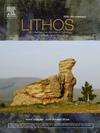Mineral chemistry-perspective of the Kadavur gabbro-anorthosite Complex, Southern Granulite Terrane of the Indian shield: Implications to its petrogenesis in a ridge-subduction setting
IF 2.9
2区 地球科学
Q2 GEOCHEMISTRY & GEOPHYSICS
引用次数: 0
Abstract
Mineral chemistry data of constituent silicate and oxide phases are often regarded as a useful tool for assessing the petrogenesis of mafic rocks. In view of this, the chemistry of minerals from the Kadavur gabbro-anorthosite Complex (10°35′N: 78°11′E), a magmatic intrusion in the Southern Granulite Terrane of the Indian shield, has been evaluated using several thermo-barometric methods and tectonic discrimination diagrams. The Complex represents a magmatic intrusion that consists of a highly deformed schistose gabbro-anorthosite type and an undeformed layered gabbro-anorthosite type, with local patches of pegmatoidal gabbro-anorthosite bodies. The constituent minerals in the Complex include clinopyroxene, orthopyroxene, plagioclase, amphibole, and subordinate amounts of ilmenite and magnetite. Pyroxene thermometry (clinopyroxene thermometry, orthopyroxene thermometry and two pyroxene thermometry) gives mean temperatures of ∼1060 °C for the layered gabbro- anorthosite bodies, and ∼ 1124 °C for the pegmatoidal bodies; and ∼ 1130 °C for the schistose gabbro-anorthosite. Hornblende-plagioclase and amphibole thermometry give temperatures of ∼1000–1190 °C. The co-existing oxide (magnetite-ilmenite) thermometry gives a lower temperature of ∼420 °C. The mean clinopyroxene pressure value is 17 kbar for the schistose gabbro-anorthosite, 9 kbar for the layered gabbro-anorthosite, and 11 kbar for the pegmatoid bodies. During the earlier phase of deformation associated with magmatic crystallization (responsible for schistose type), the ambient temperature and pressure of crystallization of the Complex were 955 to 1285°C at ∼17 kbar. The magma equilibrated at shallow to intermediate levels allowing for localized input of H2O. Consideration of whole-rock geochemical data (especially immobile trace elements) indicates that parent magma was of tholeiitic and alkaline composition and later underwent fractionation. The rare earth element (REE) distribution in the schistose gabbro-anorthosite is broadly similar to that of N-MORB, while the geochemical characteristics of the layered gabbro-anorthosite resemble island arc basalt (IAB). The pegmatoidal gabbro-anorthosite bodies have a transitional affinity between both the N-MORB and IAB. The mineral chemistry and whole-rock geochemistry data suggest that the schistose gabbro-anorthosite mostly corresponds to “non orogenic” and “MORB-type” while layered gabbro-anorthosite and pegmatoid bodies correspond to an ‘orogenic’ and ‘island-arc’ setting, suggesting a clear shift from a MORB setting to an arc-setting suggesting a ridge-subduction event. The Kadavur gabbro-anorthosite Complex is analogous to other well-known Archaean gabbro-anorthosite Complexes around the world.
印度盾区南麻粒岩地体Kadavur辉长-斜长杂岩的矿物化学特征及其在脊-俯冲背景下的成岩意义
组成硅酸盐和氧化相的矿物化学数据通常被认为是评价基性岩成因的有用工具。在此基础上,利用热气压法和构造判别图,对印度盾构南麻粒岩地体岩浆侵入体Kadavur辉长-斜长杂岩(10°35′n: 78°11′e)的矿物化学特征进行了评价。该杂岩体是由高度变形的片岩辉长斜长岩型和未变形的层状辉长斜长岩型组成的岩浆侵入体,局部呈伟晶状辉长斜长岩体。杂岩的组成矿物包括斜辉石、正辉石、斜长石、角闪石,以及少量的钛铁矿和磁铁矿。辉石测温法(斜辉石测温法、正辉石测温法和双辉石测温法)显示,层状辉长岩-斜长岩体的平均温度为~ 1060℃,伟晶岩体的平均温度为~ 1124℃;片麻辉长斜长岩为~ 1130°C。角闪斜长石和角闪洞测温给出的温度为~ 1000-1190℃。共存的氧化物(磁铁矿-钛铁矿)测温得到的温度较低,为~ 420℃。片状辉长斜长岩的斜辉石平均压力值为17 kbar,层状辉长斜长岩的斜辉石平均压力值为9 kbar,伟晶岩体的斜辉石平均压力值为11 kbar。在与岩浆结晶相关的早期变形阶段(负责片岩类型),络合物结晶的环境温度和压力为955至1285°C,约17 kbar。岩浆在浅层到中层达到平衡,允许局部的水输入。全岩地球化学资料(尤其是不可移动的微量元素)表明母岩浆为拉斑岩和碱性成分,并经历了分馏作用。片状辉长斜长岩的稀土元素(REE)分布与N-MORB大致相似,而层状辉长斜长岩的地球化学特征与岛弧玄武岩(IAB)相似。伟晶长辉长斜长岩体在N-MORB和IAB之间具有过渡亲和力。矿物化学和全岩地球化学数据表明,片状辉长斜长岩多对应“非造山”和“MORB型”,而层状辉长斜长岩和伟晶样岩体则对应“造山”和“岛弧”环境,表明从MORB环境向弧环境的明显转变,表明发生了脊-俯冲事件。Kadavur辉长-斜长岩杂岩与世界上其他著名的太古宙辉长-斜长岩杂岩相似。
本文章由计算机程序翻译,如有差异,请以英文原文为准。
求助全文
约1分钟内获得全文
求助全文
来源期刊

Lithos
地学-地球化学与地球物理
CiteScore
6.80
自引率
11.40%
发文量
286
审稿时长
3.5 months
期刊介绍:
Lithos publishes original research papers on the petrology, geochemistry and petrogenesis of igneous and metamorphic rocks. Papers on mineralogy/mineral physics related to petrology and petrogenetic problems are also welcomed.
 求助内容:
求助内容: 应助结果提醒方式:
应助结果提醒方式:


